The Outdoor learning benefits for students: How to enhance your lessons through outdoor education
We share the many benefits of outdoor learning and how you can use this in your lessons outside of school trips.
We often associate outdoor learning with subjects like geography and history because of the regular field trips.
However, every subject can benefit from incorporating outdoor learning experiences.
And it doesn’t have to mean expensive school trips either!
Some of the main benefits outdoor education brings are enhancing problem-solving skills, communication, resilience, exploration, experimentation, and developing contextual learning.
Here are 14 outdoor learning benefits:
Outdoor learning benefits
Outdoor learning is a great way to bring tangible cognitive, social, physical and mental benefits to children and support future life skills.
Let’s dive into the key benefits.
Outdoor education improves mental health
According to the World Health Organization, 10-20% of young people suffer from poor mental health, so student’s mental well being is a critical part of today’s education.
One of the main outdoor learning benefits is that it reduces stress and anxiety and improves our mood by decreasing the stress hormone cortisol.
Depending on the age of the children you teach, consider one of these activities to boost mental health:
A nature walk around the school
Take things outside the classroom and go on a nature walk.
Encourage students to stop, listen, look, and smell at different locations. They could collate their responses with a sensory map, in which they describe a space based on the sensory observations.
Afterwards, ask them to discuss their observations and compare where they felt happiest.
Field sketching
For older students, enhance your nature walk with field sketching by asking children to sketch what they can see.
This activity builds their creativity skills and helps compare human and physical features around the school.
“Outdoor learning improves child development, supports mental health and wellbeing, deepens nature connections and promotes more inclusive and engaging learning.” –Learning Through Landscapes
Outdoor learning boosts confidence and resilience
Research shows that children’s (especially girls) self-esteem starts to dip by 30% from as young as eight years old.
While boosting self-confidence may not be listed in the curriculum, an unwritten part of teachers roles is to help build their students resilience.
Higher self-esteem helps support better engagement and progress in lessons as students will be more willing to experiment, take risks and push themselves in their learning.

Boosting self confidence outside the classroom can be as simple as:
Spot unlikely beauty
Read the poem ‘The Rose That Grew From Concrete’ by Tupac Shaku and discuss the meaning with your class.
Go outside and, in small groups, ask students to explore the school grounds to look for examples of something growing in impossible places, for example, a flower through the cracks of a wall. Back in the classroom, ask students to share what they found.
This activity helps children learn that nature can thrive despite difficult conditions… And so can they!
Start an outdoor club
Encourage students to explore the great outdoors with an after-school club!
You can enjoy fun activities like geocaching, orienteering and growing plants for a fun way to reap the benefits of outdoor learning.
“Immersive experiences in nature, such as education outside the classroom, have been found to enhance self-esteem and increase self-efficacy in children” –Teach Outdoors
Encourages risk taking
Risk taking is a great way to build children’s self-esteem and resilience.
However, research from the University of Houston shows that enclosed classrooms can increase student’s risk aversion.
An environment where children will start risk taking includes:
A classroom culture that encourages taking risks for learning
Normalises making mistakes
Celebrates learning from mistakes
Here are some outdoor learning activities to encourage risk taking:
Map and orienteering
Set up an activity where your students navigate through the school grounds with a site map.
You can incorporate other subjects, like languages, where students can break a code by deciphering the language… Think educational treasure hunt!
Read outside
Sometimes children find it easier to concentrate on reading or listening to stories outside in quiet surroundings.
Ask students to sit comfortably or lie back and close their eyes.
When you create a relaxing environment, your students may feel confident enough to volunteer to read or answer questions.
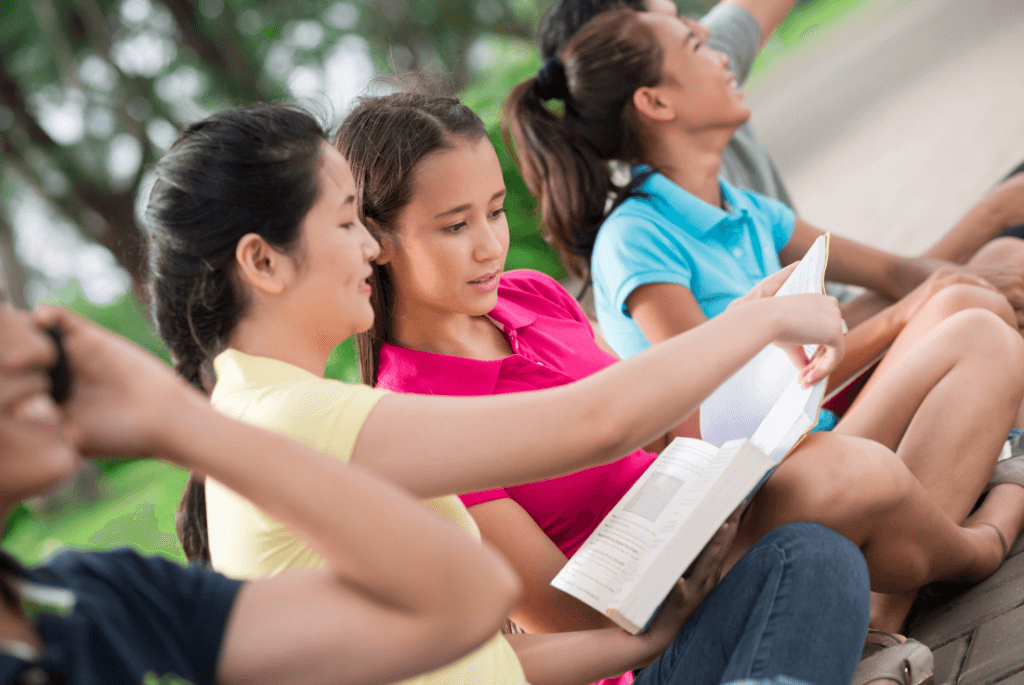
Strengthens language and communication skills
Outdoor learning brings opportunities for team challenges, which is excellent for improving children’s language and communication skills.
There are two sides to this topic. For some children, particularly those who are neurodivergent, a peaceful place outdoors can bring calm and encourage them to still the sensory overload inside and find their voice.
For others, if you find an outside space with plenty of room to run and stretch, they will find their voice through excitement, exercise, playing together or team games.
As the teacher, you will know what suits your learners best and what outdoor opportunities you have on your school grounds or fieldwork. Here are a couple of suggestions:
Collect natural artefacts
Ask your students to explore the area to find examples of natural artefacts like tree bark, leaves and twigs. Encourage their communication skills by asking them to discuss their findings in small groups.
Conversation starters can include why they chose the object, what it shows, and what part of the environment it fits into.
Create art from nature
Ask students to collect natural items like, petals, leaves, feathers, and sticks. You can do this either around the school or during a field trip.
In the classroom or outdoors, ask students to work together to create artwork that incorporates their new treasures.
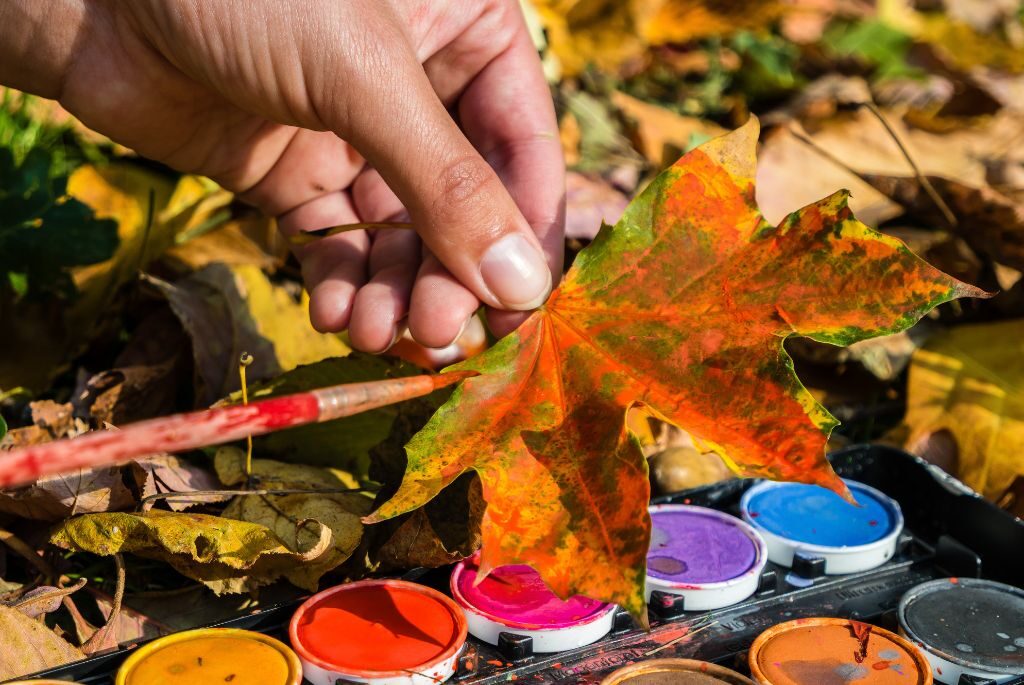
Outside thesaurus
Next time you’re outdoors, ask your students to come up with alternative words to describe natural features, like clouds, trees, and the weather.
A simple way to boost descriptive skills while playing outdoors!
Develops physical skills
Learning outside the classroom brings opportunities to develop physical skills through challenges like balancing, navigating, running, climbing and outdoor yoga.
Also, manipulating materials like rocks, sticks, and leaves can help develop fine motor skills.
The extra space and ability to get messier than in the classroom brings scope for more challenging activities like:
tone skimming
If you can take students to the beach, give stone-skimming a go!
Spend time choosing the perfect stone, trying it out and making it competitive. Plus this is a great way to introduce conversations about geology!
Build cairns
Whether you’re at school or on a field trip, building a tall pile of stones, also known as a cairn, can help develop physical skills by working on balance.
Enhance the activity by asking questions like “Can your structure cope with water being poured on it?”
Build dams
There are lots of ways you can introduce construction within outdoor learning but building dams to control the flow of water in a stream is always a winner!
This will combine cognitive decision-making with fine and gross motor skills.
Builds problem solving skills
Outdoor learning experiences are great for problem solving activities because there is more space for children to work together.
Give these outdoor learning activities a go to build your students’ problem solving skills and develop environmental awareness:
Design (and build!) a school garden
Designing a garden for your school is a great way to encourage critical thinking. Encourage students to think about how they’ll build their garden and how it can be sustainable.
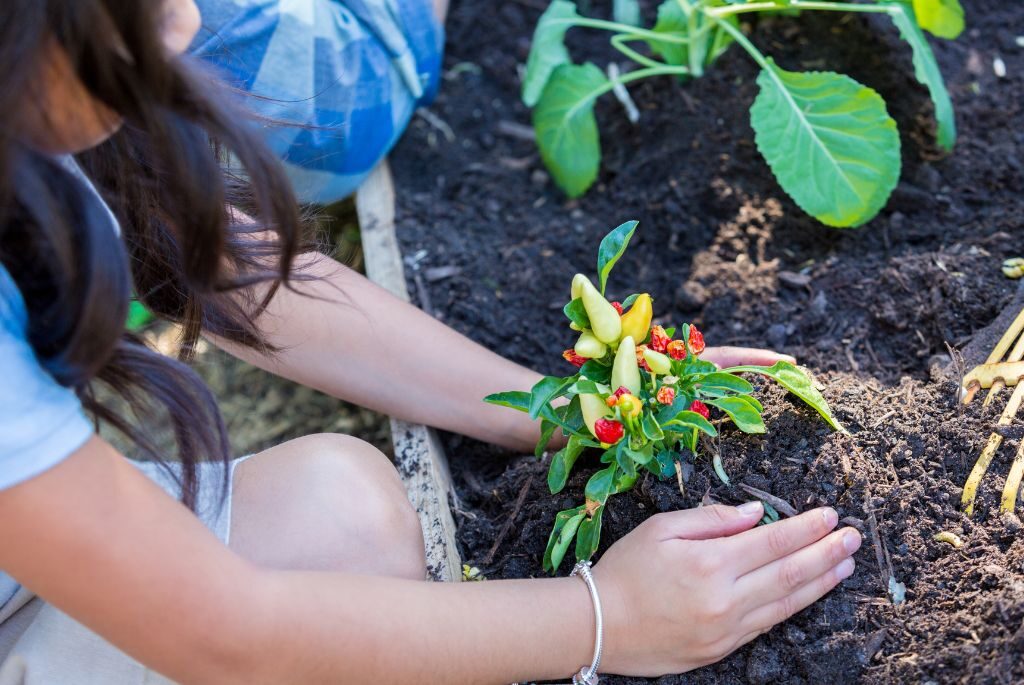
Analyse your school’s impact
Investigative learning can improve problem solving skills. One way to do this is by asking students to plan how they’d reduce the impact your school has on the natural environment. Another effective way to build their analytical skills!
Develops an appreciation for nature
A survey by Natural England revealed that 80% of children agreed that being in nature makes them happy. And yet children between the ages of 5 and 15 are spending less time outdoors than ever.
Spending time outdoors builds an appreciation for the natural world and eventually encourages a positive attitude towards protecting the environment.
Walk barefoot!
If you can, and with permission as needed, have children experience walking barefoot across grass or other surfaces to compare the senses. This is an eye opening activity and can help students develop a strong appreciation for the natural world beneath their feet!
Night spotting
During your next residential field trip, take students outside at night to see if they can spot anything different than during daytime.
Ask questions like “Are there more stars than back home?” and “Is there more or less noise pollution?” To make them more aware of their surroundings.
Creates environmental awareness
We can easily become blasé about places we’re familiar with and forget to appreciate the nature around us.
One of the benefits of outdoor learning is that it can help students absorb the different environmental features of their surroundings.
Maps from memory
Firstly, take your students on a guided walking tour around the school, pointing out any key features. When you’re back in the classroom, ask them to draw the school from memory.
This will heighten their awareness of their surroundings through recall.
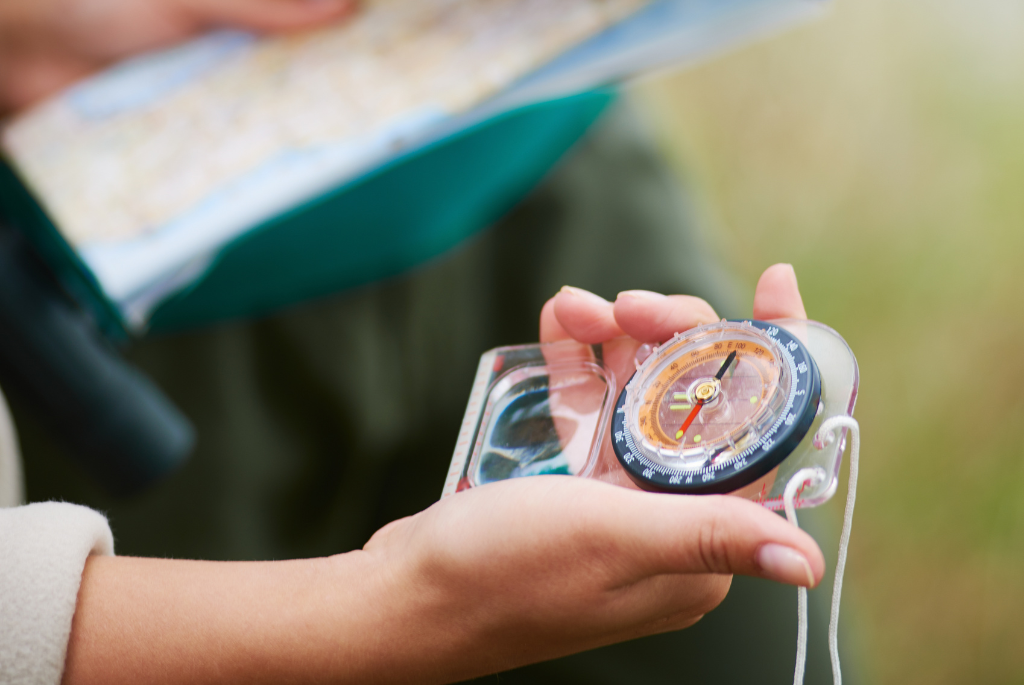
Awareness through senses
Build environmental awareness during your next field trip by asking children to stop, look, listen and feel at different points.
Remind them to think about what they can see up close as well as in the distance and to compare natural and human features.
The beauty of this activity is that it works whether you’re at a beach, river, forest, park, glacier, or volcano!
Use technology
If you allow your students to use mobile phones in school, these are some great apps that can help them develop a love for nature:
Decibel- Compares how loud different environments are
iGeology- Shows what’s happening with the ground beneath your feet
PlantSnap- Identifies different plant species
Builds social skills
Nowadays, children’s social interaction is decreasing with research showing 73% of children spend less time outdoors than ever before.
One of the major benefits of outdoor learning is the opportunity to build social skills by exploring the world together.
If you’re a teacher who’s been on school trips, you may have noticed the impact it had on your student’s social abilities as they share new experiences with their friends and often make new friendships.
A drawback to this, though, is that school trips aren’t accessible to all children without bursary schemes, so here are some activities you can include to enhance the social benefits of outdoor learning:
Incorporate music and drama
Outdoor learning naturally lends itself to group activities because of the added space and more freedom for activities at scale.
A great way to take advantage of this is by incorporating music and drama which develops social skills such as teamwork and communication.
Ecosystem investigation
Students can work together to investigate ecosystems around the school.
Working with others (especially if it’s someone they don’t usually interact with) can help develop their social skills, particularly communication and teamwork.
Provides a new learning environment
Have you noticed that your students are more engaged in lessons when they’re outdoors?
You’re not alone.
Research shows that children learn in outdoor spaces because the new environment teaches them that learning can be experienced anywhere, anytime.
When children realise that learning is not something that only occurs inside a classroom, they develop a positive attitude towards it which improves their education.
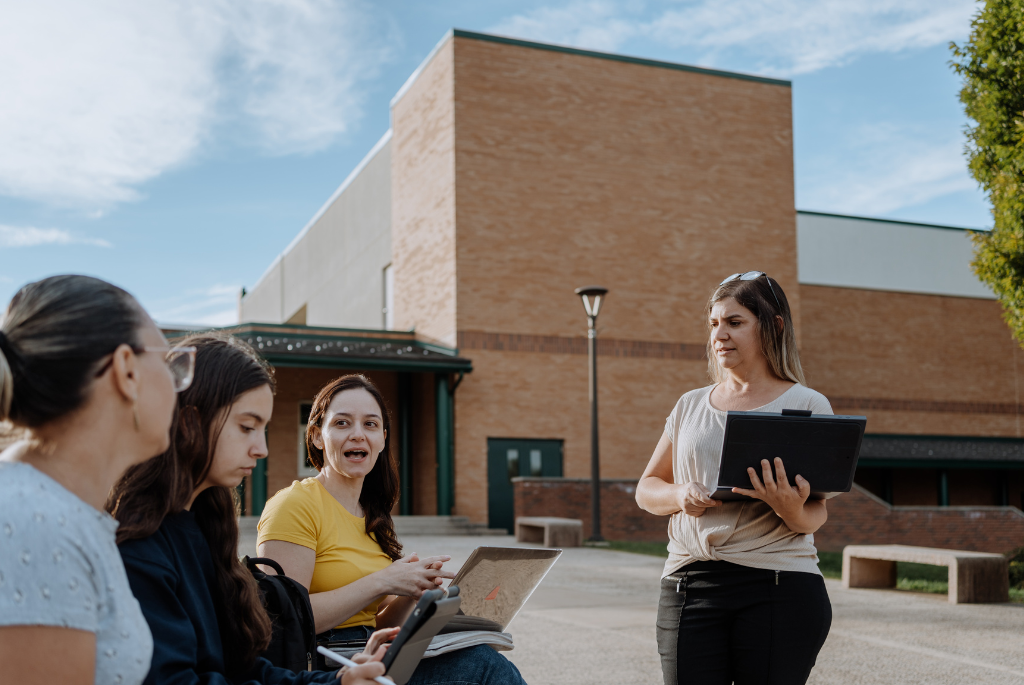
Modelling
Children could create river basin or coastal models of physical features outdoors with the freedom to use messy materials, or act out how waves move up and down a beach by moving across the field with plenty of space.
Take writing outside
An outdoor environment can offer endless inspiration.
Take your students outside to work on their extended writing in their own space.
Encourage them to use the nature around them as a stimulus by asking questions like “Describe the local ecosystem” and “How does a rural woodland compare the the school gardens?”
“88% of teachers say that children are more engaged in learning when taking lessons outdoors” –Muddy Hands Report
Provides new learning opportunities
Outdoor environments can allow for freedom for learning through action.
Simply being up close with nature can provide your students with the context they need.
For example, if you’re learning about forests, what better way to visualise the layers of the ecosystem or a food chain than by seeing it right in front of you?
Here are some outdoor learning experiences to enhance your student’s knowledge:
Landform creation
Ask students to create mini landforms outdoors. This could be river basins, which they can shape, sculpt and feel in their hands.
They are more likely to remember what they learned as they’ll lock the information in their minds through physical touch.
Practise lettering and numberwork
Who says you need a pen and paper to practice written skills?
Make nature your canvas and try asking your students to write letters and numbers in soil or sand outdoors.
This helps make the connection between touch and how the brain visualises the shapes to write them by hand.
Creates experimental learning opportunities
Do you want to encourage experimentation but don’t want a messy classroom?
Take it outdoors!
One of the benefits of outdoor learning is that there is more space and facilities for experimentation, which can help bring abstract concepts to life.
Microclimate and weather investigations
Ask children to investigate how temperature varies across the school site by comparing areas that are more or less exposed to direct light, wind, shade, etc. This will encourage analytical and enquiry skills.
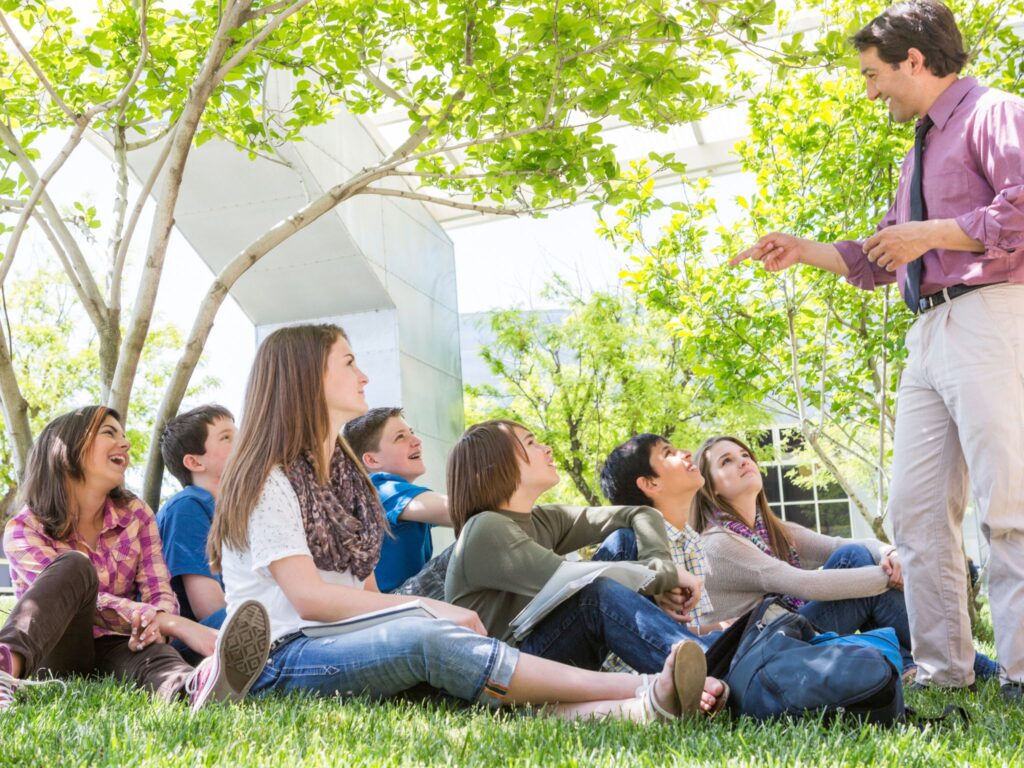
Water infiltration
Learn about how different surfaces around your school influence the infiltration of water, for example, soil, grass, concrete, etc. This will bring the water cycle to life!
Science experiments outside the classroom
You could investigate how ocean currents and acidification work, or demonstrate static electricity with balloons and bubbles. With your outdoor space providing room to do this on a bigger scale, you’ll bring the learning experience to life!
Engages multiple senses
Learning outdoors can engage multiple senses, and provide an opportunity to refresh and reboot the brain, which can have a knock-on effect on the rest of a student’s day’s learning. Almost like a kickstart.
When we engage multiple senses, it creates and strengthens neurological pathways which boosts learning.
Here are some sensory activities you can try when outdoor learning:
Traffic survey
Conduct a traffic and pedestrian survey from school by counting and recording how many people go past in a certain timeframe.
Ask children to focus on their different senses by stopping and listening to different sounds and focusing on what they can see and feel around them.
Create a sensory map
You can create a sensory map either by using hand-drawn maps, printed site maps or Google Earth layers.
Ask your students to plot key locations around your school on the map and ask them to describe what they can see, hear, smell and feel at each spot.
What is outdoor learning?
Outdoor learning doesn’t define a specific type of lesson plan or experience.
It’s a broad term that covers any learning activities that take place in nature or simple outside the classroom.
Whether your school is a leafy rural setting with plenty of green space or a confined urban setting with mostly tarmac, there are still opportunities for outdoor learning.
Children have the right to a comprehensive education and a safe environment. Outdoor learning can complement and extend classroom learning by fully including all learners, no matter their backgrounds or abilities.
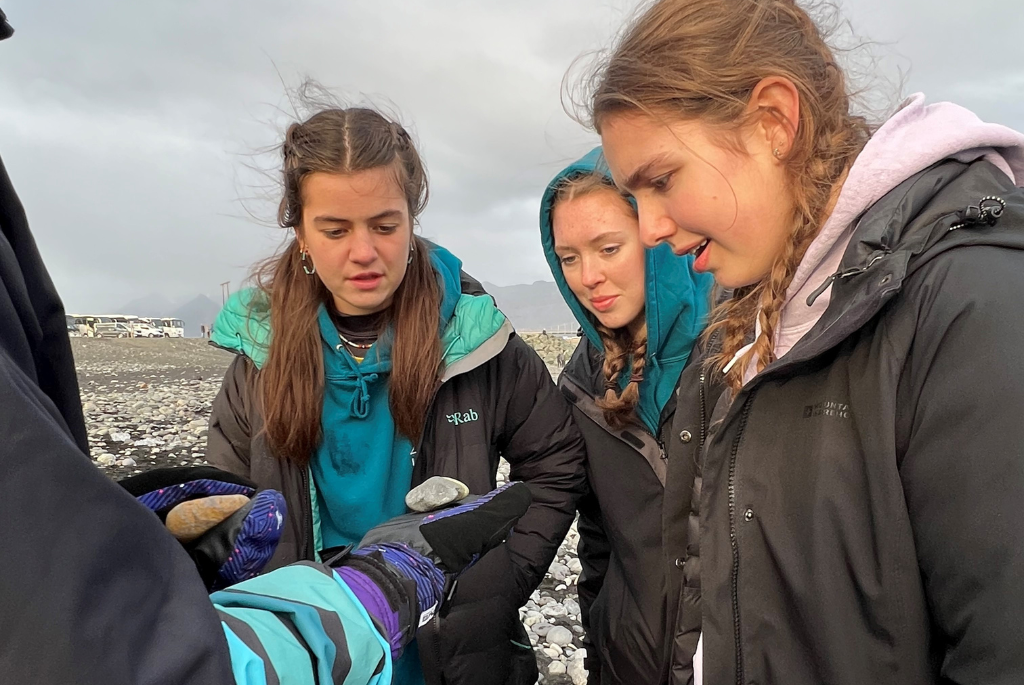
Outdoor learning is not easy, it isn’t the same as outdoor play.
It must be planned and purposeful, like all learning activities.
But there are lots of examples for different subject areas, and at all phases of education, that can be used to bring learning outside.
As teachers, we’re not just there to build knowledge.
We also help build character through holistic experiences, and outdoor learning is an excellent way to achieve this.
“Many children are under more time pressure, more peer pressure and more pressure to succeed. Getting outdoors is the cheapest and easiest way to reduce this pressure so children (and adults) feel less stressed.” – Outdoor Classroom Muddy Hands Report


